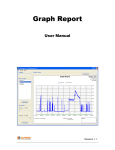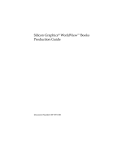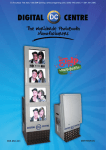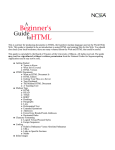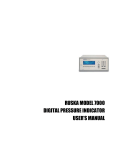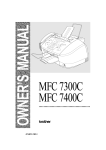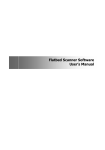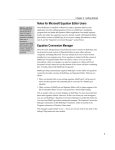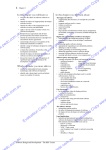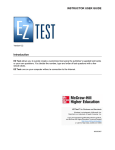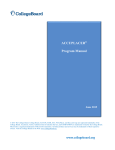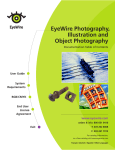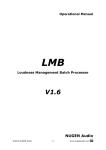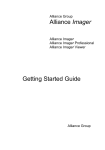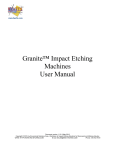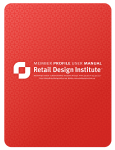Download 99.95% accuracy - An accuracy measure usually used for
Transcript
99.95% accuracy - An accuracy measure usually used for key-entry or
OCR, this number literally translates to the percentage of characters that are
correct. 99.95% means that there are no more than 5 character errors per
10,000 characters, which for typical materials translates to 1-2 erroneous
characters per page. 99.99% accuracy is 5 times as accurate with 1 error per
10,000 characters or 1 error every 5-10 pages. In DCL's electronic
conversions, the standard character accuracy level is 100%.
Aggregator - A company who specializes in selling content from multiple
sources via the Web. Generally, the aggregator's site is focused on a
particular subject matter. Although aggregators are most common in the
Scientific, Technical and Medical(STM) world, many are now popping up in
other fields such as Libraries, Technology and Education.
Ambiguous Mapping - Ambiguous mapping occurs when a particular style,
code or string maps to two or more possible SGML tags, depending on
context or content. For example, italicized text may map to an SGML tag
used to mark case names ("Smith v Jones"), an SGML tag used to mark
foreign words ("c'est la vie"), or an SGML tag used solely for emphasis
("almost"). The number of such ambiguities can usually be resolved
programmatically (e.g. italicized text with the word v is a case name).
ASP - An Active Server Page is an HTML page that includes scripts that are
processed on the server side before the page is sent to the user. The primary
purpose of using ASPs is so that a page can be tailored specifically to the
user, based on his or her preferences. Basically the page pulls information
from a database and then builds the final page on the fly before sending it to
the browser. Examples of ASPs are "My Yahoo" and the customized pages
that investment houses provide to allow you to view "your portfolio" as soon
as you sign on.
CALS Tables - This model for the representation of tabular data was
originally defined by the US Department of Defense as part of its CALS
document interchange initiative. The table model (defined in military
standard MIL-M-28001B) has become a de facto standard within the SGML
industry.
Cascading Style Sheet - CSSs allow authors and users to attach style
(e.g., fonts, spacing, and aural cues) to structured documents (e.g., HTML
documents and XML applications). CSSs separate the presentation style of
documents from the content of documents, and thereby simplify Web
authoring and site maintenance. Both Netscape and IE now support CSSs.
CGM Computer Graphics Metafile is a graphics file format developed by
experts working under the auspices of ISO and ANSI, and was designed
specifically as a common format for the platform-independent interchange of
raster (bitmap) and vector data. This format is used primarily to store vector
graphics information. CGM files typically contain either vector or raster data,
but rarely both. Used in its primary role as a vector format, it offers the
advantage of small file size and resolution independence, while not being tied
to a specific software package or hardware platform. CGM was adapted by
the Department of Defense as one of the CALS initiative standards.
Conditional Text - Conditional text allows the selective inclusion of a piece
of text in an output document based on a series of conditions. A desktop
publishing program which supports conditional text allows a user to have a
one master document with a series of variant output documents. For
example, a software manufacturer may want to distribute one user manual
to its customers and deliver the same manual with additional text to its
Technical Support people. Conditional text makes this possible. Packages
that support conditional text include FrameMaker and Bookmaster.
DPI - Dots per inch is a measure of the sharpness or resolution in an image.
Higher DPIs result in greater quality images although they can dramatically
increase file size. The effect of this is that images will print more slowly or
display more slowly on a computer screen. With the Internet, sophisticated
compression algorithms have become popular to dramatically reduce file size
without compromising quality. The JPEG format is an example of such
compression. For web display 72DPI is typical, while for printing to a
common laser printer 300 or 600 are more common. In Desktop Publishing,
DPIs are typically much higher.
DTD - A document type definition is a specific definition that follows the rules
of the Standard Generalized Markup Language (SGML). A DTD is a
specification that accompanies a document and identifies markup codes, and
the rules for their use. SGML documents need to be parsed or validated to
ensure that they conform to the DTD. A DTD is optional with XML, but highly
recommended with more complex document sets.
GIF - Graphics Interchange Format is the most common format for graphic
images on the Internet. This highly-compressed format is used to display 2dimensional raster images. A newer version, GIF 89a allows for an animated
GIF, which is a short sequence of images within a single GIF file. GIF files
are generally not used for photographs on the Web; JPEGs are optimized for
that purpose.
The LZW compression algorithm used in the GIF format is owned by Unisys,
and companies that make products that use the algorithm need to license its
use from Unisys.
"Glass Typewriter" - This particular problem is very often an issue with
data authored in the days preceding the sophisticated desktop publishing
packages and word processors we know today. On older, proprietary
document systems, data was often formatted inconsistently with the singular
goal that it appear correctly on screen. This “glass typewriter” approach is
not uncommon, and while it served its function for display purposes, it
greatly reduced the underlying structural integrity of the data. Most
markedly, the practice greatly increases the complexity and effort of
enhancing and converting data to more structured formats like XML, SGML,
and FrameMaker.
HTML - Hypertext Markup Language is the set of "markup" codes or tags
inserted in files intended for display on the World Wide Web. This markup
tells the Web browser how to display a Web page's text and images.
Examples of typical HTML tagging include the following:
<html><title>American Ski Association Welcome</title> <h1>The Joy Of
Skiing</h1> <h4>by Jim Smith</h4> <h2>Introduction</h2> <p>Skiing is
one of the fastest growing sports in America. This book is a tribute to the
sport and a how-to guide to getting started. We hope that you enjoy it, and
get out on the slopes real soon!</p> <p><b>Note:</b> All opinions
expressed in this book belong to the author.</p> </html>
HTML is a standard recommended by the World Wide Web Consortium (W3C)
and adhered to by the major browsers.
IETM - Interactive Electronic Technical Manual. This technical manual is
usually stored on CD-ROM and provides for unique user interactivity. In
general, the IETM helps do away with the page-turning that is normally
associated with paper manuals in order to see referenced figures, tables,
chapters, etc and to do trouble-shooting. In the case of referenced figures
and tables, etc., the IETM lets the user hyperlink directly to the referenced
item. In a trouble-shooting section, the user simply clicks on the current
problem and the IETM walks him/her through the trouble-shooting process
by specifying a trouble-shooting test and the possible results of the test.
JPEG - Joint Photographic Experts Group files are used for monochrome,
gray scale or full-color digital still images. JPEGs use compression to
tremendously decrease file size while still maintaining high image quality.
JPEG has become the de facto standard for photographs on the Web.
Mapping - In the context of XML/SGML conversions, this means the
specification of the SGML tagging to be produced when a particular style
(paragraph or font), coding, or string of text is found in the input file. For
example, the ChapTitle style may map to the SGML tagging
<chapter><title>...</title>, meaning that when the paragraph style
ChapTitle is found in the input file, then the SGML-encoding software will
produce <chapter><title>...</title> with the "..." representing the text
found in the paragraph styled as "ChapTitle".
Master Format - In DCL's conversion methodology, this is a format into
which all incoming data is converted in order to standardize it for further
conversion processing. DCL's master format uses SGML as its base. From
here, data can be converted to multiple output formats, and even to multiple
DTDs. The major advantage of this approach is that all incoming formats can
be normalized into a common dataset on which DCL's conversion software
can operate. The approach also facilitates multi-purposing of the same data
for multiple output formats.
MathML - The Mathematical Markup Language, is an XML based language
used for displaying mathematical notation and content, especially on the
web. It is a World Wide Web Consortium (W3C) recommended standard, and
has been receiving increasing support by mathematical software vendors.
OCR - Optical Character Recognition is a visual recognition process that turns
printed or written text into an electronic character based file. The process
involves photo-scanning of the text character-by-character, analysis of the
scanned-in image, and then translation of the character image into character
codes, typically ASCII. In OCR processing, the page image is scanned, then
analyzed for light and dark areas in order to identify each alphabetic letter or
numeric digit. Popular commercial OCR packages include the Xerox
company's TextBridge and Adobe's Acrobat Capture.
Parse - While traditionally a concept of syntax and grammar validation,
when used in relation to mark-up languages, this terms refers to a process of
validating files by checking that tags are applied legally according to a predefined structure. This structure is typically defined by the Document Type
Definition (DTD). Common terms used in mark-up validation are "parser" (a
piece of software that validates) and "parsed".
PDF - Portable Document Format ("PDF") reproduces the documents almost
precisely as they were originally composed, provides built-in compression, is
supported by all popular operating systems and is compatible with most
printers. The freely available Adobe Acrobat Reader is required to view, print
and search PDF documents. The PDF format was developed by Adobe, is
modeled after the PostScript language, and is both device and resolution
independent.
While mark-up languages are generally preferred for content-oriented
materials, PDF files are especially useful for documents where appearance is
critical. A PDF file contains one or more page images, each of which you can
zoom in on or out from.
Raster - Also referred to as bitmap images, these are images that are
represented by a sequence of pixels (picture elements) or points, which when
taken together, describe the display of an image on an output device. There
are many different raster image formats in use, among them GIF, JPEG, PCX,
and TIFF.
Resolution - Resolution refers to the number of pixels (individual points of
color) contained on a display monitor. The number is expressed in terms of
the number of pixels on the horizontal axis and the number on the vertical
axis. The sharpness of the image on a screen depends on both the resolution
and the size of the monitor. The same pixel resolution will gradually lose
sharpness as monitor size increases because the same number of pixels are
now being spread over a larger physical area. Resolution is similar to DPI
except that DPI is more typically used in regards to printed output.
Sample Markup - An initial step in the Proof of Concept phase, this refers
to the text of a sample document with the SGML tags inserted. The sample
markup may be a hardcopy document with the tags written in or it may be
an electronic SGML file along with the corresponding hardcopy.
SGML - Standard Generalized Markup Language is an internationally agreed
standard for information representation. SGML can be used for publishing in
its broadest definition - from single medium conventional publishing on paper
to on-line multi-media database publishing. SGML can be used to produce
files which can be read by people, and exchanged between machines and
applications in a straightforward manner.
Styled - Most modern word processing and desktop publishing programs
allow the user to supply a base stylesheet (sometimes called a template) so
that 'like' paragraphs can all have a similar look. A document is called 'styled'
if the component paragraphs are produced by use of these styles.
Stylesheet - A master document template made up of a collection of styles.
Most desktop publishing and word processing packages come with a standard
stylesheet (also called template) that includes styles for things such as firstlevel headings and bulleted list items. Stylesheets are critical to enforcing
structure and consistency across document sets, especially where multiple
authors are involved.
Template - see stylesheet.
Text Frames - Text Frames are popular in desktop publishing, and are used
to position text absolutely on a page. Many of the popular magazines that
you read render sidebars and the like by using text frames. Text frames or
boxes can significantly complicate the conversion process because they do
not follow the logical 'story' structure of the document.
TIFF - Tag Image File Format is a common format for exchanging raster
(bitmapped) images between application programs. Usually identified with
the ".tiff" or ".tif" filename extension, the format was developed in 1986 by
an industry committee chaired by the Aldus Corporation (now part of Adobe).
Microsoft and Hewlett-Packard were also on the committee. One of the more
common image formats, TIFFs are common in desktop publishing, faxing,
and medical imaging applications.
Unstyled - Unstyled documents are produced by using specific text
formatting (such as justification, emphasis, tabs, indents, and font selection)
for each paragraph individually, rather then by giving them a specific
appearance based on selection of a particular style from a preselected
stylesheet. This approach undermines the structural integrity of a document
and often leads to inconsistency within a set of documents. Unstyled
materials add tremendously to the task of performing large-scale automated
conversions.
Vector - Vector images are images that are represented by collections of
independent line and shape objects which are typically defined by
mathematical formulas. This makes these images easier to modify than
raster images. Popular vector image programs include Adobe Illustrator,
CorelDraw, and AutoCad. Typically, each program will have its own vector file
format.
WYSIWYG (pronounced "wiz-ee-wig") - Literally, What-You-See-Is-WhatYou-Get, this refers to an editor or program that incorporates a graphical
user interface (GUI) so that a developer (usually working with code or
markup) can see the end result while creating the document. Many products
now exist for web design that allow pages to be build graphically without the
user having an in-depth knowledge of the underlying HTML code. Adobe's
PageMill and Microsoft's Front Page are such products.
XML - Extensible Markup Language is a subset of ISO 8879, Standard
Generalized Markup Language (SGML). XML has been designed specifically to
function on the Web, and both major browsers support it. Currently a formal
recommendation from the World Wide Web Consortium (W3C), XML is similar
to HTML in that both XML and HTML contain markup symbols to describe the
contents of a page or file. HTML, however, describes the content of a Web
page only in terms of how it is to be displayed. XML describes the content in
terms of what the data is that is being described. For example the
<authname><affil> tags could indicate that the data following it was an
author's name and his affiliation. This allows an XML file to be processed
purely as data by a program as well as being displayed in a certain way. XML
is "extensible" because, unlike HTML, the markup symbols are unlimited and
self-defining.
XSL - Extensible Stylesheet Language is a stylesheet language that gives us
the ability to specify how data coded with XML will format on screen. This
language was developed based on the ISO companion standard for SGML
known as DSSSL (Document Style Semantics and Specification Language.)






